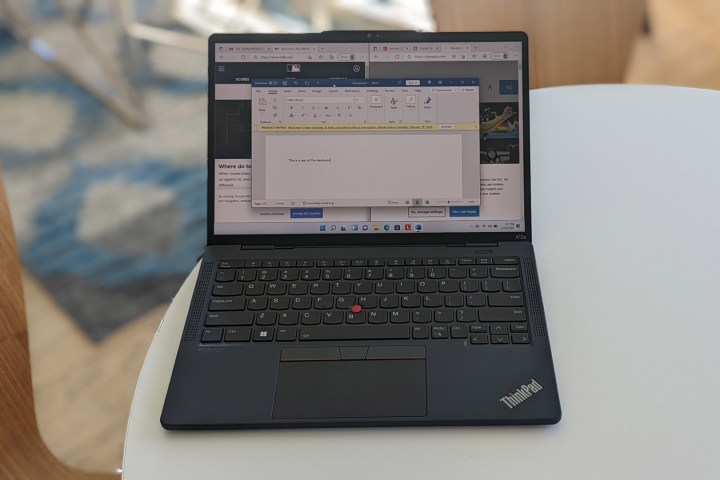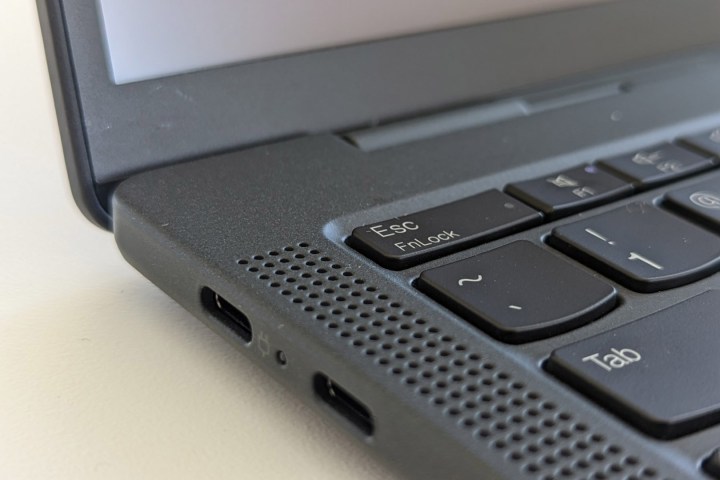
Lenovo’s best laptops have always had Intel or AMD inside, but in a first, there’s now a new ThinkPad powered by Qualcomm’s Snapdragon 8cx Gen 3 compute platform.
More specifically, it is the ThinkPad X13s, an ARM-powered device that’s unlike a regular ThinkPad in more ways than one. With promising always-on, always-connected performance and a fantastic sustainable design, this Lenovo laptop feels different from past Windows on ARM devices, and after trying one ahead of Mobile World Congress, it dares to take on Apple’s M1 MacBooks in the business realm.

Specs
| Lenovo ThinkPad X13s | |
| Dimensions | 11.76 x 8.13 x 0.53 inches |
| Weight | 2.35 pounds |
| Processor | Snapdragon 8cx Gen 3 |
| Graphics | Adreno GPU |
| RAM | Up to 32GB LPDDR4 |
| Display | 13.3-inch WUXGA (1920 x 1200), at 16:10 aspect ratio |
| Storage | Up to 1TB PCIe SSD |
| Touch | Included on some models |
| Ports | 2 USB-C 3.2 Gen 2, audio jack, SIM card tray |
| Wireless | Wi-Fi 6 and 6E, 5G sub6 eSIM, 5G mmWave eSIM |
| Webcam | 5MP Windows Hello Webcam |
| Operating system | Windows 11 Pro |
| Battery | 49.5 Wh Li-ion polymer, video playback up to 28 hours. |
| Price, availability | $1,099, May 2022 |
Design

On the outside, the ThinkPad X13s looks a lot like a standard Lenovo business laptop might at first glance. It sports a “Thunder Black” color, but things change once you run your hands at the side. There, you won’t find any ventilation fans, which is a signature feature of ARM-powered Windows devices just like this one.
The devices’ corners are also rounded, making the laptop comfortable to grab and hold with one hand — important since this is something to use when on the go. Yet, Lenovo is thinking about sustainability, which, in principle, is what makes this design a little different.
If you’re curious, without the fans, the laptop is still thin and light, at around 11.76 by 8.13 by 0.53 inches and 2.35 pounds, but Lenovo isn’t just using regular materials to keep the profile slim. The ThinkPad X13s is designed out of 90% recycled magnesium on the top and bottom covers and is also manufactured with low-temperature solder.

Elsewhere, 97% post-consumer content recycled plastic is used on the speaker enclosure, 30% of the same content in the battery, and 30% again in the wall adapter. This all helps reduce emissions and helps make the world a greener place for everyone.
It’s a nice environmental change from Apple’s M1 MacBooks, where just the enclosure is made of 100% recycled aluminum. In the Windows space, it reminds me a lot of HP’s Dragonfly laptop, which is made from 80% recycled content in its mechanical parts.
All that comes at no sacrifice to durability either. Pushing on the keyboard didn’t cause the chassis to bend, and the lid has no flex to it at all. It shouldn’t be a surprise, as the ThinkPad X13s is MIL-SPEC 810H tested with 12 methods, 26 procedures, and 200 additional quality checks.
Display

The 16:10 slim-bezel display is what is becoming more common in laptops these days, and I was happy to see one on the ThinkPad X13s. Tuned to the WUXGA resolution of (1920 x 1200), this laptop is one that will let you get your multitasking done right.
In my time with the device, I pulled up Microsoft Edge and stacked windows side by side. I got an even view of web pages, with more room to scroll thanks to the wider 16:10 ratio. I also pulled up nature videos on YouTube, and while the ThinkPad was in direct sunlight, the display still was clear and crisp. I clearly made out all the details in a video showcasing Italy’s landscapes.

The peak 300 nits of brightness on the panel I was hands-on with might be too low for some people, and far from the brightness of MacBooks. But for basic web browsing and office work, this might be enough to get the job done without looking too washed out.
Keyboard and trackpad

To no surprise, the ThinkPad X13s sports an amazing keyboard and trackpad. If you’ve ever used a ThinkPad before, then you know the deal. The keys have amazing travel distance and the feedback as you push into the chassis is nice and smooth. The trackpad, meanwhile, is smooth as butter, making scrolling and gliding through web pages an easy task.
You’ll even find Lenovo’s signature TrackPoint, which can help you move your mouse around more precisely than the glass-like ThinkPad TrackPad below. For fun, I ran a typing test and I got to around 87 words per minute, which is above my average of around 80 wpm.
Ports and connectivity

Apple’s new 2021 M1 MacBooks bring back the legacy HDMI port, but in the Windows on ARM space, things are different. Many laptop makers are sticking to USB-C to keep devices thin and light, and, that’s what ends up happening with the ThinkPad X13s. But there are some added connectivity benefits you won’t find on an M1 MacBook.
On the ThinkPad X13s, you’ll find 2 USB-C 3.2 Gen 2 ports, an audio jack, as well as a SIM card tray. Other than that, there’s native support for 5G-enabled Sub 6 and 5G mmWave connectivity, which is the thing that’s absent on Apple’s M1-powered MacBooks.
It wasn’t available for me to test, but Lenovo says that the device can switch to 5G mmWave, 4G LTE, or sub6 Wireless WAN for “lightning-fast, highly secure, on-the-go connectivity.” This is the first 5G ThinkPad, even though this is far from the first 5G Windows laptop.
There have been others, like the HP Elite Dragonfly G2 or the Lenovo Flex 5G. 5G and LTE laptops offer always-connected benefits, especially when away from Wi-Fi, as I’ve talked about before, and this ThinkPad is no different.
Webcam

Another unique feature of the ThinkPad X13s is the communication bar at the top of the device. It sports three far-field 360-degree microphones and a 5-megapixel webcam. When I turned that webcam on, I was delighted to see the quality. I made out the fine threads in my mask, as well as the background colors of the sofa I was sitting on.
Lenovo also says that it worked with Qualcomm and Microsoft to enable some special communications features on this ThinkPad. I didn’t get to try these out, however. There’s A.I.-based auto framing to keep you in the frame on Teams calls. Intelligent noise suppression is also available during video conference calls to mute out background noises on both ends of calls.
There’s even a neat trick, where the ThinkPad can sense human presence by automatically turning off or dimming the display when the user looks away. Other features include posture and screen-time awareness, as well as vision-health notifications. This is all thanks to the Snapdragon 8cx Gen 3’s computer vision processor.
Performance and battery life

In the past, we’ve disliked laptops and tablets with Qualcomm processors for lackluster performance and app-emulation issues. Microsoft has made improvements with 64-bit app-emulation in Windows 11 on ARM devices, though, and Qualcomm’s new Snapdragon 8cx promises big performance gains as well. This all combines to give the ThinkPad X13s Apple M1 potential in terms of performance.
Previously leaked benchmarks have shown that the Snapdragon 8cx is as good as a U-series Intel 12th generation 25-watt processor. It’s no wonder why Lenovo promises that system-level performance on this device can be boosted by up to 57% and multi-tasking can be up to 85% faster.
After trying out the ThinkPad X13s which has this very chip, I can’t help but feel that I got a peek at that performance. Of course, I wasn’t able to run benchmarks, but for the web browsing I did, the chip was able to keep up.

A mix of Microsoft Edge tabs, office apps like Word and PowerPoint, and other system apps all ran smoothly on the device. I opened up Task Manager to check, and the system’s CPU usage was barely at 5% in my unscientific tests. Even putting the device into sleep and out of sleep was buttery smooth, and I was right away able to jump back into the action.
A lot of Microsoft apps are now optimized for ARM processors, and Lenovo tells me that Microsoft’s Azure program ensures native compatibility and unchanged experiences for business-critical applications on this device. Microsoft even built the Pluton security chip for this ThinkPad and put it in the Qualcomm Secure Processing Unit. This security chip allows for chip-to-cloud protection of user identity, data, and applications.
As far as battery life, Lenovo is promising up to 28 hours of video playback. We’re looking forward to testing that claim but have found that the average battery life isn’t too far off from Intel machines. This is unscientific, but the system I tested was at 100% when I took it off the charger and went down to around 95% only after 45 minutes.
Price and availability
ThinkPad X13s will be available starting May 2022, starting from $1,099. In the U.S., the ThinkPad X13s will be available on AT&T, and on Verizon later in 2022. More specific availability and pricing will be shared later.


